#Achaemenid
Text

Stater, minted 380/379 BCE at Tarsus in Cilicia, of Pharnabazus II, former satrap of Hellespontine Phrygia under the Achaemenid dynasty of Persia and a major figure in the internecine conflicts of the Greek city-states during the late 5th/early 4th centuries. The coin shows the complex intermingling of Greek and Near Eastern cultures characteristic of Anatolia under Achaemenid rule. On the obverse, Ba'al of Tarsus is shown seated, holding a lotus-tipped scepter and wearing the Greek chlamys. On the reverse, a bearded man wears a helmet in Attic style. Both sides are inscribed in Aramaic, which served as the lingua franca of the Near East under the Achaemenids. Photo credit: Classical Numismatic Group, Inc. http://www.cngcoins.com
#history#ancient history#classics#tagamemnon#Persian Empire#Achaemenid#coins#ancient coins#Persian coins#numismatics#ancient numismatics#artifacts#artefacts
66 notes
·
View notes
Text

~ Man and woman in loving embrace.
Place of origin: Iraq, Nippur
Period: Achaemenid Period
Date: 450 B.C.
Culture: Near Eastern
Medium: Terracotta
#ancient#ancient art#history#museum#archeology#ancient sculpture#ancient history#archaeology#man and woman in a loving embrace#man#woman#love#hug#embrace#nippur#iraq#near east#near eastern#achaemenid#450 b.c.
938 notes
·
View notes
Text
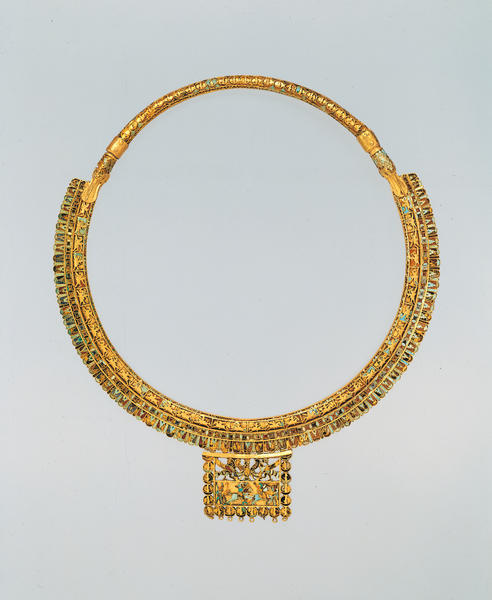

Gold pectoral inlaid with turquoise, lapis lazuli, glass, and carnelian, Achaemenid Empire, 6th-4th century BC
from The Miho Museum, Kyoto
659 notes
·
View notes
Text

achaemenid rug 𓃬
#based on reliefs of shahriar defeating a winged lion/gryphon#persepolis#ancient history#achaemenid#ancient persia
201 notes
·
View notes
Text

People wonder how Alexander was such a strategic genius...well I'm sure he had a lot of "brainstorming" sessions ;^)
Drawing these guys is so fun and it's like I'm in my own fandom, making food for only myself. Just a one man fandom ='D
🔶Full image on my paytree0n!
#alexander of macedon#alexander the great#achaemenid#ancient persia#ancient greece#bagoas#persian boy#my art
88 notes
·
View notes
Text


Gold bracelets with turquoise and garnets, Achaemenid Empire, 530 - 500 BC
from Artemis Gallery
401 notes
·
View notes
Text
So, this is gonna be a bit of a read, but I thought of a little AU idea and I kind of wrote a mock Prologue for it???
(yes I drew little doodles for it. End me lol)

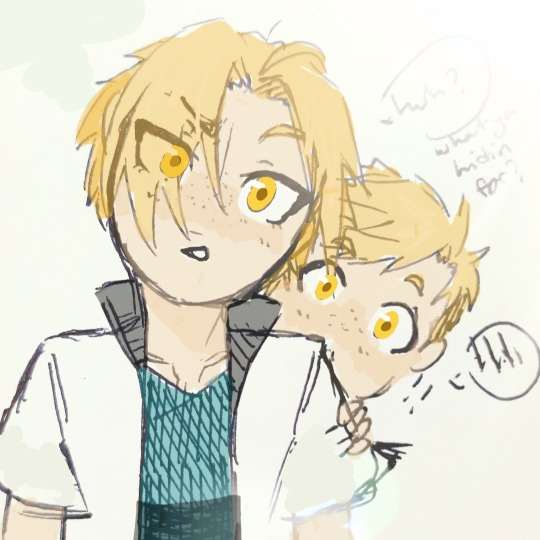
Since it's set back in time when Xerxes was still a bustling empire, I figured Amestris would be in the 15th century of sorts. (Yes I know Amestris wasn't even made yet, but in this Medieval/Xerxes AU it is!)
Cause I looked into it and figured out Xerxes fell around 1480 or so?? So we're going with medieval Amestris.
It starts out with the trio being young (like 6 and 5 years of age) just so you have an idea.
So if y'all wouldn't mind taking a moment to read this little (3000?) Word excerpt I created out of my ass today, that would be awesome! Not promising it's in character or good 🤣👌🏽
TITLE: Achaemenid
PROLOGUE
Xerxes, a stand alone empire betwixt Xing and Amestris. No one dared challenge or overthrow this stretch of desert as a result of its King. He was ruthless and heartless at times. Yet Communicable and selfless at others. Alongside his majesty stilling the hearts of his enemies, no one particularly wanted such a vast wasteland. Nor could they grasp why an empire rose within the center of it.
The air surrounding Xerxes, upon approaching, was different somehow. No one could place it. All who came to the border of Xerxian territory felt as though something had passed through them or vice versa. The conspicuous distinction in the clearity of the desert sky on the other side of this “border” felt unnerving yet reassuring. At least the air looked sand free the closer the caravan trudged to their destination. The only effective means of travel in the desert was by camel back. Any other means was surely suicide.
“Are thee thirsty?”
The traveling company consisted of four camels, but five riders. Three were knights, bequeathed the honour of smuggling the remaining Rockbell family line from further extinction. They had been labeled traitors in their home country, Amestris. Despite being but a lowly old hag and orphaned child, the Queen wanted blood for crimes they had not committed. Someone on the inside, took action and fabricated the plan to get them to safety before the Queen decreed their sentence.
“Drink, before thy self run dry.”
The knight’s clothed arm held steady in front of Pinako Rockbell. She huffed a thank you, her aggravation more towards the scorching heat than him. After taking a drink herself, she gave the rest to Winry Rockbell, who sat in her lap.
“Drink child.”
Winry took the flask in her tiny hands, touching it to her lips and tilted it back. Finishing with a gasp of air, she felt much better. But a refreshing drink of water did nothing to wash away the fact that her parents were dead and are perceived to be traitors. She knew, without a doubt, that they were most certainly not. She wanted to cry again, but recalled granny telling her to conserve her fluids. This journey had been longer than she anticipated.
Finally coming across life of some kind, the caravan ventured across a bridge stretching over an irrigation system that seemed to go for miles in opposite directions. There were people actively digging the system down below. Hearing hooves shuffle across the stone, a handful of them turned to look up.
Winry ducked her head to escape their gaze, but soon was in awe of their odd features. Each and every one of them had gold hair that varied in shades. But what really caught her attention were the array of amber gold eyes staring her way. They varied in intensity as well, but each was piercing in their own right. She couldn't look away. After staring a moment, the people began to wave an arm in greeting in unison, smiles on their faces. They were oddly friendly to strangers. The people down below disappeared over the hump of the bridge once they crossed it and made it back to land, moreso sand.
The knight's accompanying them steered their herd towards a stable like building meant for housing the camels of travelers for their later departure. Except, they weren't leaving anytime soon, Winry thought. The knight's would leave them behind to burn under the hot sun. Although, now that they were in town, the sun didn't seem that bad anymore, but it still weighed on them.
Given Granny’s and Winry's size, the knights had to help them down off of the towering camels safely. Granny didn't like a grown man touching her, but she figured it would be best not to complain. They did all this for them. She took Winry's hand since she didn't feel safe in a foreign land whatsoever.
“Stay by my side, Winry.”
Winry noded and hid behind her as they walked down the center of the shopping district. A perfect place to attract travelers for money. Everyone they passed seemed to be happy to see them or at least friendly. Some would talk to each other and watch them pass. Granny didn't like being on display like this, she squeezed Winry's hand.
It felt like ages, but they finally walked to the center of the empire and scaled the thousands of stairs it took to get to the throne room. Winry wanted to slap this King or whatever. No one would want to come here and climb a mountain of stairs just for a King.
Once they basked in the vast throne room, the knights turned to Granny.
“Ma’am, the lass need not pay the King audience. Only thee must accompany us.” The knight speaking bowed, but Granny didn't like this idea.
“I'm not leaving her alone. She comes with me.”
“Ma’am…the King wouldn't-”
He was cut off by a tall young man, sporting a blonde beard and hair pulled back in a ponytail. “If I may?”
Pinako looked over and up to glare at whoever else wanted to take Winry from her. “Who are you? I'm not leaving her.”
The man put up his hands in surrender. He didn't take being yelled at very well. “I mean no harm, ma’am. Id like to suggest taking your…..granddaughter for the time being. I have two boys of my own she could distract herself with. I'm sure your conversation with the King will be short and sweet.”
“Like hell you think im-”
“Please please. I promise no harm will come to her. The King doesn't like children in his throne room. She would just upset him. Me on the other hand, I love them. She'll be safe with me.” He gave a pause and looked Pinako in the eyes, putting his hands together in a prayer form. “I promise.”
Pinako didn't care how many times he repeated himself, she didn't like this at all. Leaving her only granddaughter with a random stranger did not sit well with her.
The knight cut in this time. “Make haste, the King doesnt take nicely to waiting.”
“Alright alright. Fine. Get off my back will ya!” Pinako grumbled, turning to Winry. She grabbed both of Winry's hands this time and squeezed. “Winry. I don't want to do this, but you're going to be spending some time with that man there. I'll be back as soon as I can, okay?”
Winry nods. “Okay, Granny.” She looked to the blonde man smiling down at her. He wasn't unnerving or creepy. He looked really sweet and nice. He held his hand out and looked from Winry to Pinako.
“I will take good care of her for you. She'll have fun with my boys, I know it. Come come.”
Winry slowly took his hand and let go of Pinako’s. Neither looking like they wanted to go anywhere. Winry watched Granny go through the big double doors and disappear. She'd be lying if she wasn't worried now.
“Oh where are my manners,” the man smiled down at her while walking her down a corridor. “My name is Von Hohenhiem. What’s-”
“Winry.”
Her sudden response gave him pause, but Hohenhiem smiled anyway. “I know this is stressful and scary, but I promise you'll be just fine. There's nothing to fear now. Through here.”
He guided her through an archway, pushing aside fabric in the way to reveal what looked to be a library with an open floor in the center.
“Boys! We have company.”
No response. He smiles nervously down at Winry. Clearing his throat he tried again.
“Edward! Alphonse!”
He was complimented by a grumble and shuffling of books falling over.
“I'm coming! I'm coming! I was just getting to a good part!”
A moment later, a boy appeared from around a bookshelf, not looking happy to be disturbed. He wore robes like his father with red trim. His hair short in the back, but long in the front, most of it covering the sides of his face. He blinked, seeming disturbed by Winry, obviously not expecting someone else. Turning to look back he sighed.
“Come on Al.”
Another boy poked his head out, hiding behind his brother. Much more shy than the first one. He also wore a robe like his brother, but with blue trim.
As they stepped closer to her, Winry got a closer look at their golden features. She could make out more detail compared to the people under the bridge. These two boys sported the most brilliant golden eyes out of all the eyes she's seen on the way in here. She couldn't help but stare.
“Winry. These are my boys. The one with the sour expression is Edward. The one hiding is Alphonse. Now, I have some work to do for the King. Play nice boys. Don't make her cry.” Hohenhiem looks from Al to Ed. “Edward.”
The boy named Edward had obviously taken offense to this.
“Wha- I haven't done anything yet!” Crossing his arms he looks at Winry, but it looks more like a glare.
“Be nice, I'll let you know when your granny is ready for you, Winry dear.”
Winry nods, watching him leave as the fabric falls back in the doorway, she turns back to Ed and Al.
Collectively, they all stare at each other. Winry couldn't help but notice Al still hiding behind his brother.
“Umm….” Winry started, but Ed cut her off.
“Sooo, Winry huh? What do you wanna do then? All we have are books and some toys. Not much though. We're just slaves after all…” Ed huffs, lowering his arms and resting them on his hips.
“Slaves?” Winry looked worried.
“Yeah, slaves.” He tilted it head at her, his golden hair falling in his face a bit. “Don't you have those where you're from?”
“But you all look the same…”
Edward cocked an eyebrow. “What does that have to do with it? Only the alchemists live well here.” He shrugged but put on a proud smile and pointed at himself with his thumb, puffing his chest out. “Soon we'll be skilled alchemists and surpass those losers!”
Al spoke up for the first time from behind Ed, pushing down on his left shoulder. “Brother-” He hissed at him. “Don't say that out loud, they might hear you….”
“Whatever, Al, it won't matter when we're out of here!” Ed absolutely beamed at his brother.
“Al…chemists?” Winry blinked, completely dumbfounded. “What in the world is that?”
Ed and Al turned their heads and looked at her in unison. Almost in sync. “You don't know what Alchemy is?” They even spoke in unison too.
Winry shook her head, her hair swishing in her face.
Ed looked at Al and Al looked at Ed. They smiled and looked back to Winry. They bursted with energy at her and grabbed both her hands, she almost ran out of the room.
“Come on!”
“We’ll show you!”
Yanking her into the room’s center, there was a carpet lain out for play. They let go of her and ran in random directions, searching through books and scrolls. Winry opted to stand on the very edge of the carpet, deciding to keep her distance. Both boys looked like they wanted to show her a new strange rock they found in the forest or something of the like.
Edward emerged first carrying a scroll and chalk sticks. Alphonse had bottles and jars of unknown substances. Winry was more curious now. If they were this interested in something like this, whatever it was, it must be cool.
Ed rolled up the carpet aggressively and chucked it aside. Holding open a scroll, he read off of it and began drawing lines on the stone floor. Winry was confused now. Was this Alchemy? Drawing on the floors in chalk?
As Ed finished, it was clear to Winry that it was a giant circle with triangles and writing she couldn't understand.
“What-?”
Edward tisked. “Not done yet.”
Winry shut her mouth.
Al gave him a few jars of….stuff and they both opened them and poured out the contents in the center.
“Now the material.”
“Ready?”
They got down to their knees and smiled at each other at opposite sides of the circle.
“Ready.”
A few moments went by, nothing. Winey was about to say something again when the chalk started to glow. She couldnt believe her eyes, her mouth fell open. What felt like wind was circling around the outer circle. Lights and sparks erupted from the center and triangles. The light was everywhere. The boys didn't seem bothered by this at all, they were smiling down at the pile of material they offered to the center and waited.
As the light show continued, the pile started moving. Winry's eyes grew wider. It started taking the shape of a….doll head.
That's when it got terrifying.
The doll head wiggled it's way out of the pile along with a body attached. As it formed the facial features, it looks like something out of a nightmare.
Winry started to whine. But the boys didn't stop until they heard her wail.
They whipped their heads around with worry plastered on their faces. Winry was slouched on the ground crying and rubbing her eyes. Trying to get rid of the sight that bore into her eyes. She heard their footsteps and felt their hands on her arms. Trying to get her to stop crying.
“Winry! Winry! It's okay!” Alphonse was pleading with her, holding her forearm and touching her shoulder. Edward didn't know what to do. He's only ever consoled a crying Al, but that's different than a girl crying. He just hovered and looked ashamed and lost.
When the boys got her to a hiccup, she finally took her head out of her hands and looked at them in front of her. The worry was very real on their faces. They bowed their heads and slumped.
“We're sorry…”
“We didn't know it would scare you…”
Winry hiccupped, but looked over Ed's shoulder to see a fully formed, not scary, doll sitting at the center of the circle. She looked back to sets of golden eyes looking at her. One of them looked like they were about to cry too. She smiled a little. They were only trying to show her something and make her happy.
She was about to ask if she could have the doll when Hohenhiem whipped the fabric at the doorway open.
“I heard crying! Edward, what did you do??”
The remorse on Ed's face was gone in a flash. He jumped up and huffed, stomping his feet.
“I didn't do nothing!”
Hohenhiem scanned the tosseled rug and the obvious circle drawn on the floor. He slouched and sighed, pinching his nose.
“Did you scare her with Alchemy?”
Ed crossed his arms and turned away, puffing out his cheek. “No….”
Al stood up and gripped his robes. “Yes…” Ed whipped around and opened his arms at Al in a ‘are you serious?’ manner. Sour for being ratted on.
Hohenhiem sighed again. “I'm sorry Winry. I didn't think these two were going to immediately give you nightmares as soon as I left them alone with you. I should've known…”
Ed huffed again. “What's that supposed to mean??”
Winry’s eyes whipped from one to another. Amazed by the life in the room. Silently getting up while the other two argued, she tentatively picked up the doll and inspected it. Al quietly tapped her shoulder and smiled when she looked over.
“You can have that if you want it. It won't fall apart. It's really a real doll.” He smiled soft and sweet. “We made it just for you.”
She didn't know what would come of her life here in Xerxes now that she was stuck here for the foreseeable future, but with these two around, she knows it'll be interesting at least.
“Thanks, Al.”
#fma#fullmetal alchemist#edward elric#winry rockbell#alphonse elric#my writings#fmab#medieval au#medieval amestria au??#xerxes au#van hohenheim#prologue#achaemenid#xerxian#i dont know how to tag this lol#i tried okay??#i literally wrote this in one night#i hope its decent#i think its okay but 🤷🏽♂️#yes i want you know over and over that the xerxian children have GOLDEN hair and GOLDEN eyes#pinako rockbell#kings and knights#king xerxes#king of xerxes#now in just adding any random key work tags i can lol#edwin#ed/win
71 notes
·
View notes
Text
The fireplace:

This was actually an Achaemenid Persian lion with eagle wings. It was discovered for the first time in Hamadan(hegmataneh). During the Achaemenid period, it was one of the golden and royal vessels in which they drank in it. It's called "rhyton"
500 years BC



Also pictures are from the museum and not mine
What interesting things have you noticed in the movies?⚜️
#kingdom of heaven#baldwin iv#fandom#king baldwin iv#kingdom of heaven 2005#facts#art#history#ancient persia#ancient history#the leper king#fire place#decoration#history facts#achaemenid#movies
97 notes
·
View notes
Text
Countries that are no more: Achaemenid Empire (550BC-330BC)
It was not the first empire of Iranian peoples, but it arose as probably the greatest in terms of influence and became the measure by which all subsequent Iranian empires tended to compare themselves and its influence on culture, government & civil infrastructure would influence others beyond the span of its territory and the span of time. This is the Achaemenid Empire.
Name: In Old Persian it was known as Xšāça or the "The Kingdom or the Empire", it was named the Achaemenid Empire by later historians. Named after the ruling dynasty established by its founder Cyrus the Great who cited the name of his ancestor Haxāmaniš or Achaemenes in Greek as progenitor of the dynasty. It is sometimes also referred to as the First Persian Empire. The Greeks simply referred to it as Persia, the name which stuck for the geographic area of the Iranian plateau well into the modern era.
Language: Old Persian & Aramaic were the official languages. With Old Persian being an Iranian language that was the dynastic language of the Achaemenid ruling dynasty and the language of the Persians, an Iranian people who settled in what is now the southwestern Iranian plateau or southwest Iran circa 1,000 BC. Aramaic was a Semitic language that was the common and administrative language of the prior Neo-Assyrian & Neo-Babylonian Empires which centered in Mesopotamia or modern Iraq, Syria & Anatolian Turkey. After the Persian conquest of Babylon, the use of Aramaic remained the common tongue within the Mesopotamian regions of the empire, eventually becoming a lingua franca across the land. As the empire spread over a vast area and became increasingly multiethnic & multicultural, it absorbed many other languages among its subject peoples. These included the Semitic languages Akkadian, Phoenician & Hebrew. The Iranian language of Median among other regional Iranian languages (Sogdian, Bactrian etc). Various Anatolian languages, Elamite, Thracian & Greek among others.
Territory: 5.5 million kilometers squared or 2.1 million square miles at its peak circa 500BC. The Achaemenid Empire spanned from southern Europe in the Balkans (Greece, Bulgaria, European Turkey) & northwest Africa (Egypt, Libya & Sudan) in the west to its eastern stretches in the Indus Valley (Pakistan) to parts of Central Asia in the northeast. It was centered firstly in the Iranian Plateau (Iran) but also held capitals in Mesopotamia (Iraq). Territory was also found in parts of the Arabian Peninsula & the Caucausus Mountains.
Symbols & Mottos: The Shahbaz or Derafsh Shahbaz was used as the standard of Cyrus the Great, founder of the empire. It depicts a bird of prey, typically believed to be a falcon or hawk (occasionally an eagle) sometimes rendered gold against a red backdrop and depicts the bird holding two orbs in its talons and adorned with an orb likewise above its head. The symbolism was meant to depict the bird guiding the Iranian peoples to conquest and to showcase aggression & strength coupled with dignity. The imperial family often kept falcons for the pastime of falconry.
Religion: The ancient Iranian religion of Zoroastrianism served as the official religion of the empire. It was adopted among the Persian elite & and had its unique beliefs but also helped introduce the concept of free-will among its believers, an idea to influence Judaism, Christianity & Islam in later centuries. Despite this official religion, there was a tolerance for local practices within the subject regions of the empire. The ancient Mesopotamian religion in Babylon & Assyria, Judaism, the Ancient Greek & Egyptian religions & Vedic Hinduism in India was likewise tolerated as well. The tolerance of the Achaemenids was considered a relative hallmark of their dynasty from the start. Famously, in the Old Testament of the Bible it was said that it was Cyrus the Great who freed the Jews from their Babylonian captivity and allowed them to return to their homeland of Judea in modern Israel.
Currency: Gold & silver or bimetallic use of coins became standard within the empire. The gold coins were later referred to as daric and silver as siglos. The main monetary production changes came during the rule of Darius I (522BC-486BC). Originally, they had followed the Lydian practice out of Anatolia of producing coins with gold, but the practice was simplified & refined under the Achaemenids.
Population: The estimates vary ranging from a low end of 17 million to 35 million people on the upper end circa 500BC. The official numbers are hard to determine with certainty but are generally accepted in the tens of millions with the aforementioned 17-35 million being the most reasonable range based on available sources.
Government: The government of the Achaemenid Empire was a hereditary monarchy ruled by a king or shah or later referred to as the ShahanShah or King of Kings, this is roughly equivalent to later use of the term Emperor. Achaemenid rulers due the unprecedented size of their empire held a host of titles which varied overtime but included: King of Kings, Great King, King of Persia, King of Babylon, Pharaoh of Egypt, King of the World, King of the Universe or King of Countries. Cyrus the Great founded the dynasty with his conquest first of the Median Empire and subsequently the Neo-Babylonians and Lydians. He established four different capitals from which to rule: Pasargadae as his first in Persia (southwest central Iran), Ecbatana taken from the Medians in western Iran's Zagros Mountains. The other two capitals being Susa in southwest Iran near and Babylon in modern Iraq which was taken from the Neo-Babylonians. Later Persepolis was made a ceremonial capital too. The ShahanShah or King of Kings was also coupled with the concept of divine rule or the divinity of kings, a concept that was to prove influential in other territories for centuries to come.
While ultimate authority resided with the King of Kings and their bureaucracy could be at times fairly centralized. There was an expansive regional bureaucracy that had a degree of autonomy under the satrapy system. The satraps were the regional governors in service to the King of Kings. The Median Empire had satraps before the Persians but used local kings they conquered as client kings. The Persians did not allow this because of the divine reverence for their ShahanShah. Cyrus the Great established governors as non-royal viceroys on his behalf, though in practice they could rule like kings in all but name for their respective regions. Their administration was over their respective region which varied overtime from 26 to 36 under Darius I. Satraps collected taxes, acted as head over local leaders and bureaucracy, served as supreme judge in their region to settle disputes and criminal cases. They also had to protect the road & postal system established by the King of Kings from bandits and rebels. A council of Persians were sent to assist the satrap with administration, but locals (non-Persian) could likewise be admitted these councils. To ensure loyalty to the ShahanShah, royal secretaries & emissaries were sent as well to support & report back the condition of each satrapy. The so called "eye of the king" made annual inspections of the satrapy to ensure its good condition met the King of Kings' expectations.
Generals in chief were originally made separate to the satrap to divide the civil and military spheres of government & were responsible for military recruitment but in time if central authority from the ShahanShah waned, these could be fused into one with the satrap and general in chiefs becoming hereditary positions.
To convey messages across the widespread road system built within the empire, including the impressive 2,700 km Royal Road which spanned from Susa in Iran to Sardis in Western Anatolia, the angarium (Greek word) were an institution of royal messengers mounted on horseback to ride to the reaches of the empire conveying postage. They were exclusively loyal to the King of Kings. It is said a message could be reached to anywhere within the empire within 15 days to the empire's vast system of relay stations, passing message from rider to rider along its main roads.
Military: The military of the Achaemenids consisted of mostly land based forces: infantry & cavalry but did also eventually include a navy.
Its most famous unit was the 10,000-man strong Immortals. The Immortals were used as elite heavy infantry were ornately dressed. They were said to be constantly as 10,000 men because for any man killed, he was immediately replaced. Armed with shields, scale armor and with a variety of weapons from short spears to swords, daggers, slings, bows & arrows.
The sparabara were the first line of infantry armed with shields and spears. These served as the backbone of the army. Forming shield walls to defend the Persian archers. They were said to ably handle most opponents and could stop enemy arrows though their shields were vulnerable to enemy spears.
There was also the takabara light infantry and though is little known of them it seems they served as garrison troops and skirmishers akin to the Greek peltast of the age.
The cavalry consisted of four distinct groups: chariot driven archers used to shoot down and break up enemy formations, ideally on flat grounds. There was also the traditional horse mounted cavalry and also camel mounted cavalry, both served the traditional cavalry functions and fielded a mix of armor and weapons. Finally, there was the use of war elephants which were brought in from India on the empire's eastern reaches. These provided archers and a massive way to physically & psychologically break opposing forces.
The navy was utilized upon the empire's reaching the Mediterranean and engaged in both battles at sea and for troop transport to areas where troops needing deploying overseas, namely in Greece.
The ethnic composition of Achaemenid military was quite varied ranging from a Persian core with other Iranian peoples such as the Medians, Sogdian, Bactrians and Scythians joining at various times. Others including Anatolians, Assyrians, Babylonians, Anatolians, Indians, Arabs, Jews, Phoenicians, Thracians, Egyptians, Ethiopians, Libyans & Greeks among others.
Their opponents ranged from the various peoples they conquered starting with the Persian conquest of the Medians to the Neo-Babylonians, Lydians, Thracians, Greeks, Egyptians, Arabs & Indians and various others. A hallmark of the empire was to allow the local traditions of subjugated areas to persist so long as garrisons were maintained, taxes were collected, local forces provided levies to the military in times of war, and they did not rebel against the central authority.
Economy: Because of the efficient and extensive road system within the vast empire, trade flourished in a way not yet seen in the varied regions it encompassed. Tax districts were established with the satrapies and could be collected with relative efficiency. Commodities such as gold & jewels from India to the grains of the Nile River valley in Egypt & the dyes of the Phoenicians passed throughout the realm's reaches. Tariffs on trade & agricultural produce provided revenue for the state.
Lifespan: The empire was founded by Cyrus the Great circa 550BC with his eventual conquest of the Median & Lydian Empires. He started out as Cyrus II, King of Persia a client kingdom of the Median Empire. His reign starting in 559BC. Having overthrown and overtaken the Medians, he turned his attention Lydia and the rest of Anatolia (Asia Minor). He later attacked the Eastern Iranian peoples in Bactria, Sogdia and others. He also crossed the Hindu Kush mountains and attacked the Indus Valley getting tribute from various cities.
Cyrus then turned his attention to the west by dealing with the Neo-Babylonian Empire. Following his victory in 539BC at the Battle of Opis, the Persians conquered the Babylonia with relative quickness.
By the time of Cyrus's death his empire had the largest recorded in world history up to that point spanning from Anatolia to the Indus.
Cyrus was succeeded by his sons Cambyses II and Bardiya. Bardiya was replaced by his distant cousin Darius I also known as Darius the Great, whose lineage would constitute a number of the subsequent King of Kings.
Darius faced many rebellions which he put down in succession. His reign is marked by changes to the currency and the largest territorial expansion of the empire. An empire at its absolute zenith. He conquered large swaths of Egypt, the Indus Valley, European Scythia, Thrace & Greece. He also had exploration of the Indian Ocean from the Indus River to Suez Egypt undertaken.
The Greek kingdom of Macedon in the north reaches of the Hellenic world voluntarily became a vassal of Persia in order to avoid destruction. This would prove to be a fateful first contact with this polity that would in time unite the Greek-speaking world in the conquest of the Achaemenid Empire. However, at the time of Darius I's the reign, there were no early indications of this course of events as Macedon was considered even by other Greek states a relative backwater.
Nevertheless, the Battle of Marathon in 490BC halted the conquest of mainland Greece for a decade and showed a check on Persia's power in ways not yet seen. It is also regarded as preserving Classical Greek civilization and is celebrated to this day as an important in the annals of Western civilization more broadly given Classical Greece & in particular Athens's influence on western culture and values.
Xerxes I, son of Darius I vowed to conquer Greece and lead a subsequent invasion in 480BC-479BC. Xerxes originally saw the submission of northern Greece including Macedon but was delayed by the Greeks at the Battle of Thermopylae, most famously by Spartan King Leonidas and his small troop (the famed 300). Though the Persians won the battle it was regarded as a costly victory and one that inspired the Greeks to further resistance. Though Athens was sacked & burnt by the Persians, the subsequent victories on sea & land at Salamis & Plataea drove the Persians back from control over Greece. Though war would rage on until 449BC with the expulsion of the Persians from Europe by the Greeks.
However, the Greeks found themselves in a civil war between Athens & Sparta and Persia having resented the Athenian led coalition against their rule which had expelled them from Europe sought to indirectly weaken the Greeks by supporting Greek factions opposed to Athens through political & financial support.
Following this reversal of fortune abroad, the Achaemenid Empire not able to regain its foothold in Europe, turned inward and focused more on its cultural development. Zoroastrianism became the de-facto official religion of the empire. Additionally, architectural achievements and improvements in its many capitals were undertaken which displayed the empire's wealth. Artaxerxes II who reigned from 405BC-358BC had the longest reign of any Achaemenid ruler and it was characterized by relative peace and stability, though he contended with a number of rebellions including the Great Satraps Revolt of 366BC-360BC which took place in Anatolia and Armenia. Though he was successful in putting down the revolt. He also found himself at war with the Spartans and began to sponsor the Athenians and others against them, showcasing the ever dynamic and changing Greco-Persian relations of the time.
Partially for safety reasons, Persepolis was once again made the capital under Artaxerxes II. He helped expand the city and create many of its monuments.
Artaxerxes III feared the satraps could no longer be trusted in western Asia and ordered their armies disbanded. He faced a campaign against them which suffered some initial defeats before overcoming these rebellions, some leaders of which sought asylum in the Kingom of Macedon under its ruler Philip II (father of Alexander the Great).
Meanwhile, Egypt had effectively become independent from central Achaemenid rule and Artaxerxes III reinvaded in around 340BC-339BC. He faced stiff resistance at times but overcame the Egyptians and the last native Egyptian Pharaoh Nectanebo II was driven from power. From that time on ancient Egypt would be ruled by foreigners who held the title Pharaoh.
Artaxerxes III also faced rebellion from the Phoenicians and originally was ejected from the area of modern coastal Lebanon, Syria & Israel but came back with a large army subsequently reconquered the area including burning the Phoenician city of Sidon down which killed thousands.
Following Artaxerxes III's death his son succeeded him but a case of political intrigue & dynastic murder followed. Eventually Darius III a distant relation within the dynasty took the throne in 336BC hoping to give his reign an element of stability.
Meanwhile in Greece, due to the military reforms and innovations of Philip II, King of Macedon, the Greek speaking world was now unified under Macedon's hegemony. With Philip II holding the title of Hegemon of the Hellenic League, a relatively unified coalition of Greek kingdoms and city-states under Macedon premiership that formed to eventually invade Persia. However, Philip was murdered before his planned invasion of Asia Minor (the Achaemenid's westernmost territory) could commence. His son Alexander III (Alexander the Great) took his father's reforms and consolidated his hold over Greece before crossing over to Anatolia himself.
Darius III had just finished reconquering some rebelling vestiges of Egypt when Alexander army crossed over into Asia Minor circa 334BC. Over the course of 10 years Alexander's major project unfolded, the Macedonian conquest of the Persian Empire. He famously defeated Persians at Granicus, Issus and Gaugamela. The latter two battles against Darius III in person. He took the King of Kings family hostage but treated them well while Darius evacuated to the far eastern reaches of his empire to evade capture. He was subsequently killed by one of his relatives & satraps Bessus, whom Alexander eventually had killed. Bessus had declared himself King of Kings though this wasn't widely recognized and most historians regard Darius III, the last legitimate ShahanShah of Achaemenids.
Alexander had taken Babylon, Susa & Persepolis by 330BC and effectively himself was now ruler of the Persian Empire or at least its western half. In addition to being King of Macedon & Hegemon of the Hellenic League, he gained the titles King of Persia, Pharaoh of Egypt & Lord of Asia. Alexander would in time eventually subdue the eastern portions of the Achaemenid realm including parts of the Indus Valley before turning back to Persia and Babylon where he subsequently became ill and died in June 323BC at age 32. Alexander's intentions it appears were never to replace the Achaemenid government & cultural structure, in fact he planned to maintain and hybridize it with his native Greek culture. He was in fact an admirer of Cyrus the Great (even restoring his tomb after looting) & adopted many Persian customs and dress. He even allowed the Persians to practice their religion and had Persian and Greeks start to serve together in his army. Following his death and with no established successor meant the empire he established which essentially was the whole Achaemenid Empire's territory in addition to the Hellenic world fragmented into different areas run by his most trusted generals who established their own dynasties. The Asian territories from Anatolia to the Indus (including Iran and Mesopotamia) gave way to the Hellenic ruled Seleucid Empire while Egypt became the Hellenic ruled Ptolemaic Kingdom. The synthesis of Persian and Greek cultures continued in the Seleucid and Greco-Bactrian kingdoms of antiquity.
The Achaemenid Empire lasted for a little over two centuries (550BC-330BC) but it casted a long shadow over history. Its influence on Iran alone has persisted into the modern age with every subsequent Persian Empire claiming to be its rightful successor from the Parthian & Sasanian Empires of pre-Islamic Iran to the Safavids of the 16th-18th century and the usage of the title Shah until the last Shah's ejection from power in the 1979 Islamic Revolution. Even the modern Islamic Republic of Iran uses Achaemenid imagery in some military regiments and plays up its importance in tourism and museums as a source of pride to Persian (Farsi) & indeed Iranian heritage. Likewise, its form of governance and the pushing of the concept of divine rights of kings would transplant from its Greek conquerors into the rest of Europe along with various other institutions such as its road & mail system, tax collection & flourishing trade. Its mix of centralized & decentralized governance. Its religious & cultural tolerance of local regions even after their conquest would likewise serve as a template for other empires throughout history too. The Achaemenid Empire served as a template for vast international & transcontinental empires that would follow in its wake & surpass its size & scope of influence. However, it is worth studying for in its time, it was unprecedented, and its innovations so admired by the likes of Alexander the Great and others echo into the modern era.
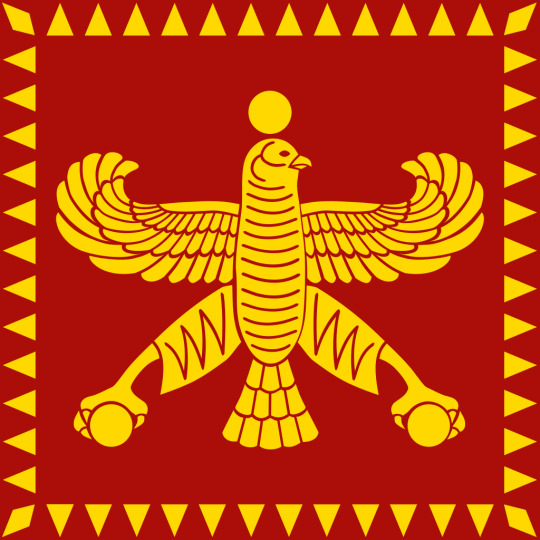
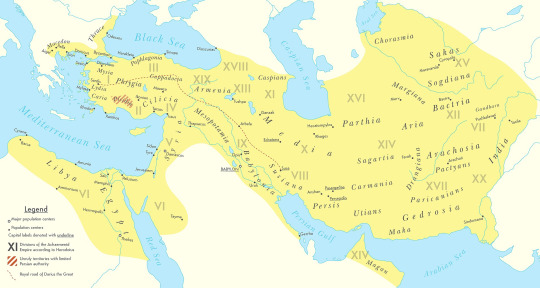


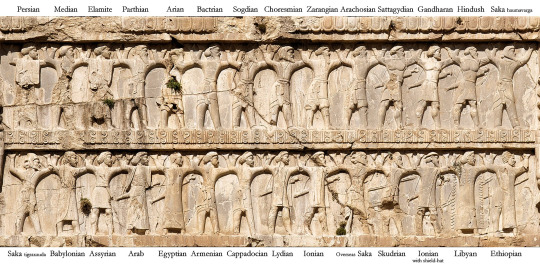
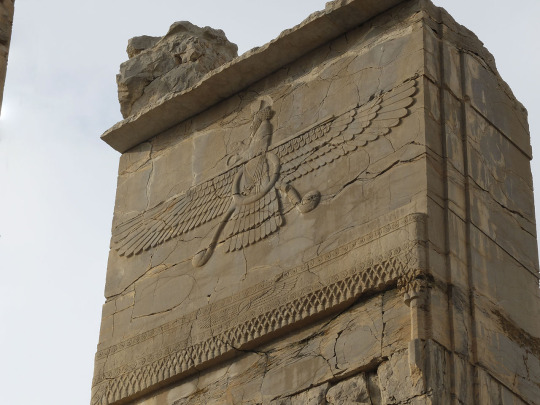




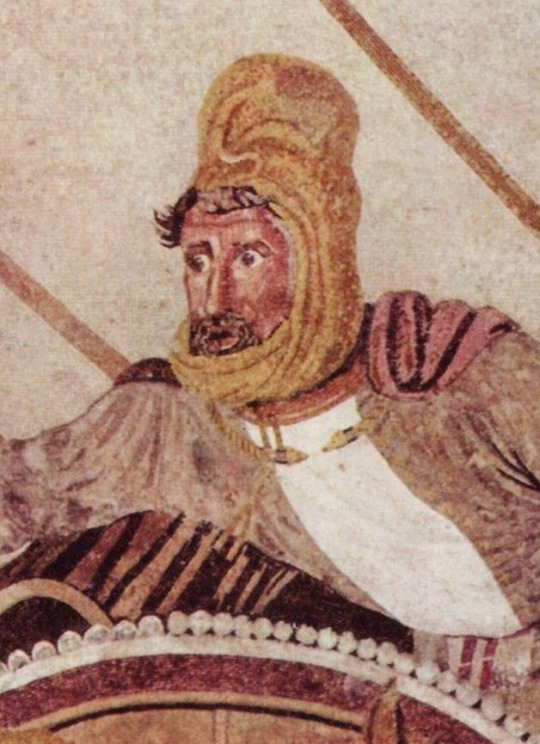
#military history#antiquity#iran#greece#ancient greece#classical greece#ancient ruins#ancient iran#ancient persia#achaemenid#persia#zoroastrianism#alexander the great#cyrus the great#xerxes#artwork#government#history#persian empire#ancient egypt
89 notes
·
View notes
Text

65 notes
·
View notes
Text

~ Clay bulla with impression of a stamp seal depicting the Persian king spearing a Greek hoplite.
Place of origin: Near Eastern, Iranian
Culture: Persian
Period: Achaemenid
Date: 550–331 B.C.
Medium: Clay
#ancient#ancient art#stamp seal#persian#persian king#king#greek hoplite#bulla#clay bulla#achaemenid#iran#iranian#near eastern#persia#550 b.c#331 b.c.#history#archeology#museum#war#battle
259 notes
·
View notes
Text

Gold and faience earring, Achaemenid Iran, 550-330 BC
from The Detroit Institute of Arts
352 notes
·
View notes
Text

Iron Socketed Spearhead from Northern Syria dated between 480-380 BCE on display at the Ashmolean Museum in Oxford, England
The archaeological site of Deve Hüyük in northern Syria was excavated by local villagers and the artefacts were bought by C.L. Wooley and T.E. Lawrence before World War 1.
Photographs taken by myself 2019
#archaeology#military history#art#ancient#iron age#syria#syrian#persian empire#achaemenid#ashmolean museum#oxford#barbucomedie
86 notes
·
View notes
Text
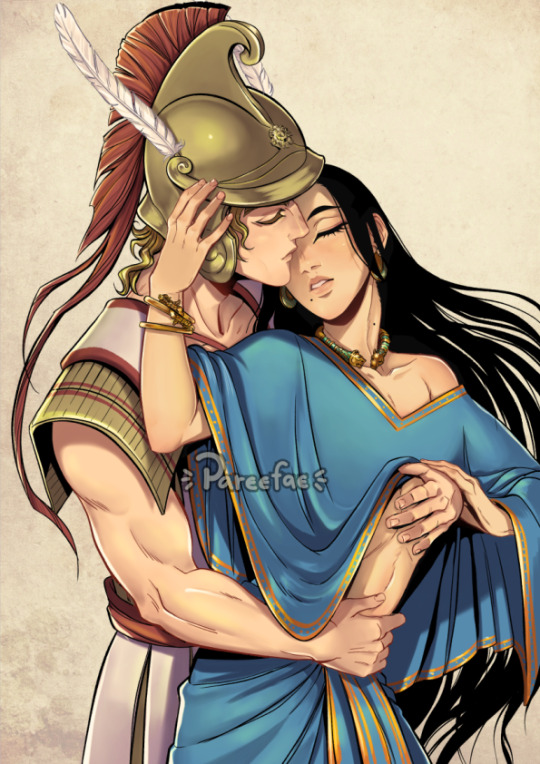
In an interesting turn of events, now I'm into a certain historic era. A friend approach me with a story based on historic personas, namely Alexander The Great and his Persian lover, Bagoas the eunuch.
I didn't know much about these people and I was instantly intrigued. Alexander had a Persian boy as a lover? Oooooh the drama. The angst. The tragedy.
So here we are. I'm in love with Bagoas. The beautiful eunuch with a tragic life. My friend and I really want to tell his story someday, from our perspective since the stories about Alexander is always told from a Greek perspective. It's time Persians do something as well!
#alexander the great#alexander of macedon#persian boy#bagoas#achaemenid#ancient persia#my art#pareefae
94 notes
·
View notes
Text
2,500-year-old circular structure with six towers unearthed in Iran reveals the architectural marvels of the Achaemenid Empire.
20 notes
·
View notes
Text

Gate of All Nations
The Gate of Xerxes -UNESCO World Heritage
(r. 486 – 465 BC) Persepolis - IRAN
The bronze trumpets that once signaled the arrival of important foreign delegations to Persepolis, the ceremonial capital of the mighty Achaemenid Empire, may now be silent, but it is still possible to capture the sense of awe while visiting the colossal Gate of Xerxes.
Built during the reign of Achaemenid king Xerxes I , who called this his Gate of All Nations, the pillared entrance is guarded by bearded and hoofed mythical figures in the style of Assyrian gate-guards.
On arrival at Persepolis one is confronted by an imposing wall, completely smooth and plain, about 15 meters tall: this is the artificial terrace on which the palaces were built. This vast terrace of Persepolis, some 450 meters long and 300 meters wide, was originally fortified on three sides by a tall wall. The only access was from the monumental staircase, which leads to the Gate of All Nations.
The gateway bears a cuneiform inscription in Old Persian, Neo-Babylonian, and Elamite languages declaring, among other things, that Xerxes is responsible for the construction of this and many beautiful wonders in Persia. Centuries of graffitists have also left their mark, including explorer Henry Morton Stanley.
A pair of colossal bulls guarded the western entrance; two man-bulls stood at the eastern doorway. Engraved above each of the four colossi is a trilingual inscription attesting to Xerxes having built and completed the gate. The doorway on the south, opening toward the Apadana, is the widest of the three.
According to sources, pivoting devices found on the inner corners of all the doors indicate that they must have had two-leaved doors, which were probably made of wood and covered with sheets of ornamented metal.
Persepolis, also known as Takht-e Jamshid, whose magnificent ruins rest at the foot of Kuh-e Rahmat ("Mountain of Mercy"), was the ceremonial capital of the Achaemenid Empire. It is situated 60 kilometers northeast of the city of Shiraz in Fars Province.
Persepolis was the seat of the government of the Achaemenid Empire, though it was designed primarily to be a showplace and spectacular center for the receptions and festivals of the kings and their empire.
The royal city ranks among the archaeological sites which have no equivalent, considering its unique architecture, urban planning, construction technology, and art.
The city was burnt by Alexander in 330 BC apparently as revenge to the Persians
The immense terrace of Persepolis was begun about 518 BC by Darius the Great, the Achaemenid Empire’s king. On this terrace, successive kings erected a series of architecturally stunning palatial buildings, among them the massive Apadana palace and the Throne Hall (“Hundred-Column Hall”).
This 13-ha ensemble of majestic approaches, monumental stairways, throne rooms (Apadana), reception rooms, and dependencies is classified among the world’s greatest archaeological sites.
#art#design#doorway#architecture#heavensdoorways#gateway#entryway#iran#persepolis#bull#royal#royal city#style#history#gates of xerses#unesco world heritage#monumental#gate of all nations#achaemenid#persia#xerxes#front door#architrave
49 notes
·
View notes